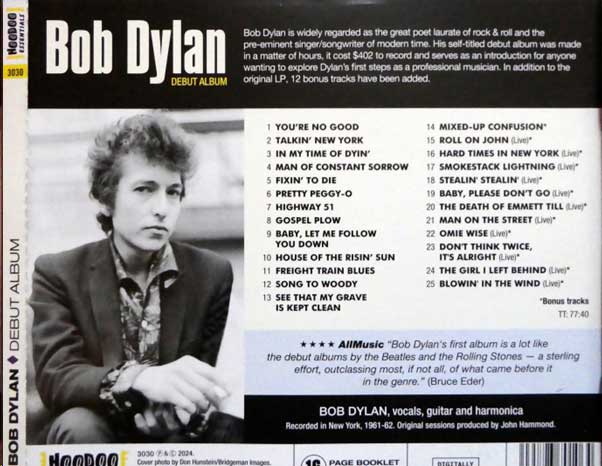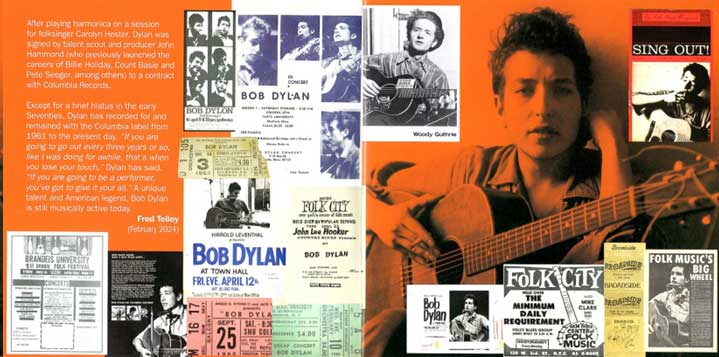
(Hoodoo Records, Re-mastered and re-issued 2024)
Observations about this new release from Alan Dearling
Approximately 63 years on since Bob Dylan’s first album was recorded for Colombia Record – here is another rather lovingly curated version. Hoodoo Essentials are an EU, Spanish-based company, specialising in copyright-free, ‘public domain’ recordings.
Bob was just 20 years old when he made the recordings. It was released a little later, early in 1962. The Hoodoo issue is the complete album plus 12 bonus tracks. It includes a curious, but no less fascinating, 16-page booklet crammed full of memorabilia, images, ticket stubs, posters and updated liner notes. The back-story to the recording of the material for the original album informs us that the debut album was made in a matter of hours. Apparently it cost just $402 to record. Much of it was produced by John Hammond.

It’s a strangely surreal experience to re-enter into Bob Dylan’s early world. A world bestowed with playing at strip-joints, bohemian folk and jazz clubs. We are almost voyeurs, listening in to the young Bob creating his own personal myths and magic, whilst he was still very much in thrall to Woody Guthrie. Although I have followed the mega ups and downs of Bob’s music and his career, it still comes as a shock to hear the experimental voices, guitar-playing and harmonica from the prototype, Dylan.
I think that this album offers a very personal listening experience – Bob seems to be intimately sharing his adaptations of traditional and original material during songs like the Scottish ‘Pretty Peggy-O’ and the Dave Van Ronk version of ‘House of the Rising Sun’.
On the original tracks which have been carefully re-mastered, it becomes abundantly clear that the whole album is filled with a raw passion. Bob appears sneering, angry, cynical and satiric. His somewhat aggressive representation of his musical worlds creates an exploding exploration beyond the confines of folk, rock-a-billy and skiffle, although there are elements of each. There are only two original songs, ‘Song to Woody’ and the chugging song-poem, the rap-like, ‘Talkin’ New York’. The other 11 tracks are a mix of original and traditional tunes and songs, many created and augmented by the likes of Eric Von Schmidt, Doc Watson, Dave Van Ronk, Jesse Fuller, Bukka White, Blind Lemon Jefferson, Ramblin’ Jack Elliott and Spider John Koerner.

As a holistic experience, it takes listeners back to a period of musical transitions. A genuine snapshot. As Dylan sings in ‘Talkin’ New York’, he tells his audience that he was a “…dollar a day” singer, criticised in the clubs, who told him, “You sound like a hill-billy”. That was before he leaves the city, and “…headed out of New York Town and headed towards western skies.” There’s gravity, a darkness in the execution of many of Dylan’s covers. These are intimately woven with the themes of death: ‘In my time of dyin’ ‘, ‘Fixin’ to die’ and the finale, ‘See that my grave is kept clean’. Unusual choices perhaps for 20 year old. But he was an assertive young poet and minstrel on a mission, one who was already mischievous, confident and self-evidently wanting to create his own mystique.
The additional twelve tracks include early and transitory versions, most of them of live recordings of Bob Dylan originals, such as ‘Mixed-up confusion’, ‘The death of Emmett Till’ and the early version of ‘Don’t think twice, it’s alright’, which includes some different lyrics. In the booklet liner notes, ‘Don’t think twice’ is credited as being recorded in 1961, but commentators have suggested that it must have been 1962. On Amazon, one critic has questioned the veracity of a number of the liner notes in the booklet. Their comments are a bit pedantic and may even be questionable. For instance, Ian WD3 suggests that:
“The track titled ‘Omie Wise’ in the booklet is actually ‘Naomi Wise’.”
I’m fairly certain that ‘Omie Wise’ is in fact the correct title of the song that Bob sings, which a song usually credited to Doc Watson. But, hey, many folk and blues singers, borrow and steal riffs and lyrics. It’s almost a definition of the evolution of ‘folk’ music! Some even refer to this as the ‘folk process’!
Bob Dylan continues to confuse and confound. He rarely plays or sings a song the same way for a second or subsequent rendition. Early on in his musical journey, he even bragged that he wanted never to play a song more than once! On the Debut Album re-release from Hoodoo there is an interview/introduction for ‘The girl I left behind’ with Oscar Brand talking with the 20 year-old Bob at the Folk Song Festival. It almost sounds reminiscent of a Monty Python sketch:
Oscar Brand: “(Bob)… you travelled around the country with the carnivals…if you travel that much, you remember a lot of songs, but doesn’t it mean you forget a lot of songs?”
Bob Dylan: “Oh yeah, I learned to forget quite a few. Once I forgot them…I then heard the name of them and looked them up in some book, and learned them over again.”
I’ve enjoyed this little musical journey into the origins and heritage of Dylan’s musical myths. Well worth checking out.

.
